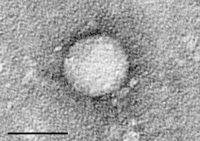
Photo from wikipedia
Objective Approximately 70% of all hepatitis C (HCV) infections develop chronic disease. Active or exacerbated chronic hepatitis C infection subsequently progress to liver disease. The role of T-cells secretions in… Click to show full abstract
Objective Approximately 70% of all hepatitis C (HCV) infections develop chronic disease. Active or exacerbated chronic hepatitis C infection subsequently progress to liver disease. The role of T-cells secretions in achieving viral clearance is still not well understood. Thus, the current study was set to determine the relationship between the T cell cytokine profiles, biochemical parameters and persistent HCV infection or spontaneous recovery. Results Twenty-five percent (41/163) of the anti-HCV positive participants had recovered from HCV and had significantly higher concentration of IL-10 compared to those with active HCV infection (P < 0.012). Other circulating cytokines measured; IL-2, IFN gamma, TNF alpha, IL-5 and IL-17 were similar in both groups. Participants with active HCV infection had significantly higher aspartate transaminase (AST) (35 units) and alanine transaminase (46 units) compared to those in the recovered state (P < 0.001). Thus, serum levels of IL10 could be explored in larger prospective cohort study as a predictive marker of recovering from an active HCV infection.
Journal Title: BMC Research Notes
Year Published: 2020
Link to full text (if available)
Share on Social Media: Sign Up to like & get
recommendations!